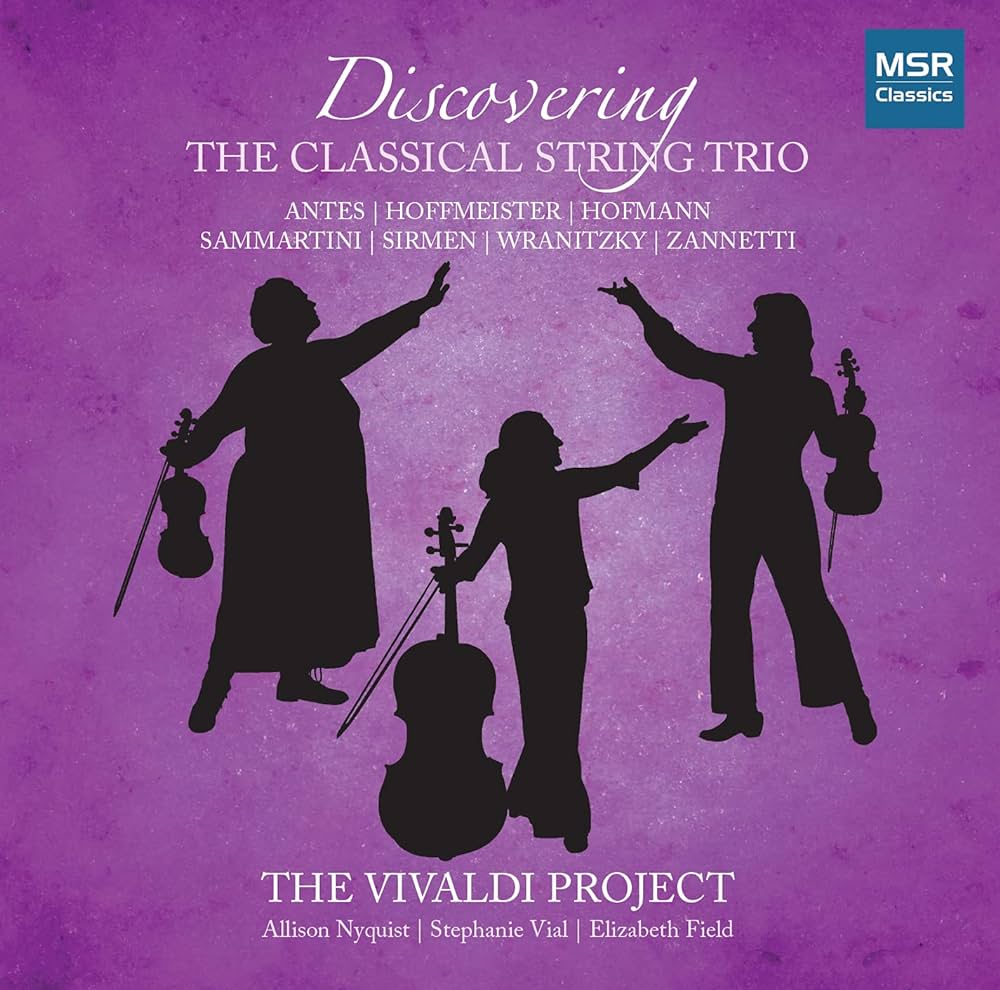 Discovering the Classical String Trio, volume 3. 2021. MSR Classics MS 1623. The Vivaldi Project (Allison Nyquist, Stephanie Vial, and Elizabeth Field). 12-page booklet with notes in English by Stephanie Vial. B/W images and score facsimiles. 19 tracks (77:25). https://www.msrcd.com/catalog/cd/MS1623. $14.95
Discovering the Classical String Trio, volume 3. 2021. MSR Classics MS 1623. The Vivaldi Project (Allison Nyquist, Stephanie Vial, and Elizabeth Field). 12-page booklet with notes in English by Stephanie Vial. B/W images and score facsimiles. 19 tracks (77:25). https://www.msrcd.com/catalog/cd/MS1623. $14.95
The Vivaldi Project’s latest release pursues this group’s mission “to both educate and delight audiences.” It is the third in a series devoted to the string trio of the mid- to late-eighteenth century, featuring works by a mixture of familiar composers—Giovanni Battista Sammartini, Leopold Hofmann, and Paul Wranitsky—and lesser known figures: Francesco Zannetti, Franz Anton Hoffmeister, John Antes, and Maddalena Lombardini Sirmen. The recording succeeds on both fronts of the ensemble’s mission, introducing listeners to a program of rarely recorded music delightfully performed on early strings.
The booklet’s program notes by the ensemble’s cellist, Stephanie Vial, assert that the aim is to correct a widely held anachronistic perception that the string trio is a “kind of minor sub-genre” and to broaden the awareness of this “essentially unknown repertoire.” If these claims of current obscurity are true, then we do indeed live in a bizarrely blinkered age. The string trio was available in huge abundance during the classical period; according to a count by Denis McCaldin, publications and manuscripts from the latter half of the eighteenth century leave us over 2,000 of these pieces to choose from. The situation with Sammartini, whose music opens this disc, hints at just how widespread was the popularity of the genre. Among the published works that bear the name G.B. Sammartini (or one of its derivatives, such as Martini, San Martino, and so forth), dozens of them can be called string trios (I count forty in his works list; Vial claims in her notes that there are over one hundred and fifty). Clearly, by Sammartini’s time, the string trio was well established.
The popularity of the string trio in the later eighteenth century should come as no surprise, given the ubiquity of the trio sonata during earlier decades. Vial calls the string trio “the successor to the immensely popular Baroque trio sonata,” a formulation that accurately represents the way that publishers marketed these works. But the string trio as an alternative to the trio sonata was not merely a publishing strategy. The Vivaldi Project recording highlights how the changing musical vernacular of the eighteenth century led to new conceptions of the roles of and balance between the various instruments in a small chamber ensemble. Sometimes, the composers of these works treat the bass instruments more as functional contributors than melodic partners. Sammartini, fully a generation older than the other composers on this disc, is a clear example of a composer who, despite an ability to write sprightly melodies, nevertheless clearly conceived of his music from the bottom up. The trio by John Antes also features a markedly conservative style; his publication’s identification of all three of the parts as “obligato” perhaps oversells the importance of the cello line, given just a couple of passages of melodic writing.
Other selections on the disc show a more melodically conceived approach, which went under the term “concertante” denoting a style in which contrasting instruments serve equal, competing roles. The trio by Maddalena Sirmen, reportedly a student of Tartini, shows keen awareness of the most up-to-date musical trends of the 1760s. The opening movement of her trio on this disc is in a mature sonata form, utilizing the high ranges of the cello as a fully participating member of thematic drama. The Zannetti selection broadens the timbral palate by incorporating viola, rather than a second violin, as one of the treble soloists, and true ecumenical virtuosity comes to the fore in the disc’s chosen trio by Wranitsky: the program booklet includes a facsimile of the original publication of the adagio, in which the cello part is written nearly entirely in treble clef.
The disc serves not only as a style survey, but also as a satisfying recital program. It presents a generous amount of material, with seven trios comprising an hour and a quarter of music. The playing sparkles, and the performers do not hesitate to dig into the emotional charge of the music, with liberal use of tempo fluctuation, ornamentation, and even the occasional extemporized cadenza. For the sake of the program as a whole, one wishes that there were less of a gap in style between Sammartini and the other composers on the disc, but omissions can be forgiven with such an extensive and neglected repertoire to choose from. How many future volumes of Discovering the String Trio might this organization produce before exhausting the possibilities? With the quality of this volume, one hopes that the answer is “many more.”


